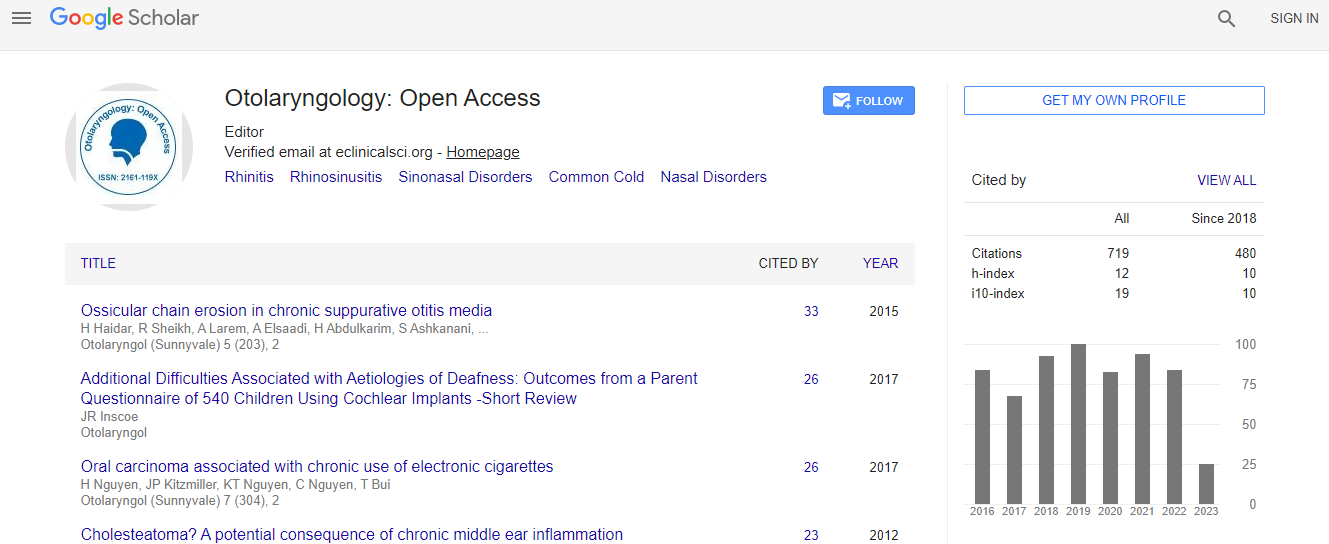Our Group organises 3000+ Global Conferenceseries Events every year across USA, Europe & Asia with support from 1000 more scientific Societies and Publishes 700+ Open Access Journals which contains over 50000 eminent personalities, reputed scientists as editorial board members.
Open Access Journals gaining more Readers and Citations
700 Journals and 15,000,000 Readers Each Journal is getting 25,000+ Readers
Google Scholar citation report
Citations : 925
Otolaryngology: Open Access received 925 citations as per Google Scholar report
Otolaryngology: Open Access peer review process verified at publons
Indexed In
- Index Copernicus
- Google Scholar
- Sherpa Romeo
- Open J Gate
- Genamics JournalSeek
- RefSeek
- Hamdard University
- EBSCO A-Z
- OCLC- WorldCat
- Publons
- Geneva Foundation for Medical Education and Research
- ICMJE
Useful Links
Recommended Journals
Related Subjects
Share This Page
An evaluation of post-operative management of children undergoing an adenotonsillectomy for obstructive sleep apnea
International Conference on Aesthetic Medicine and ENT
Reshma Ghedia
Charing Cross Hospital, UK
Posters & Accepted Abstracts: Otolaryngology
Abstract
Background & Objectives: Obstructive Sleep Apnoea (OSA) affects around 2% of children and is a result of partial or complete airway obstruction during sleep, which affects the child�s ventilation and results in disordered sleep. This subsequently leads to increased metabolic, cardiovascular and neurogenic morbidity in these children. The gold standard for investigation is overnight polysomnographic (PSG) to identify the severity of the OSA however this can be difficult to obtain and most often a decision to proceed with an adenotonsillectomy is made by history and clinical examination without a sleep study. Post-operative respiratory complications are well recognized due to previous chronic nocturnal hypoxia and resultant depression of the central ventilator drive as well as the loss of the positive end expiratory pressure (PEEP) they experienced secondary to the airway obstruction. As a result post-operative high dependency unit (HDU) beds and short stay overnight beds are requested for these children. Specific guidance as to where exactly a child with varying OSA should be monitored post-operatively is lacking and often demands for valuable resources can sometimes be unnecessary and exceed availability. Our study evaluates the post-operative management of children undergoing adenotonsillectomy for OSA at a tertiary referral Centre. Method: We performed a retrospective case note review of all patients identified to have been listed for an adenotonsillectomy plus a HDU or short-stay bed. This was for children fewer than 16 managed at a tertiary referral center over a one year period. We collected data on post-operative length of stay, oxygen desaturations, respiratory support, non-routine medications administered and transfer to higher level of care. Results: We identified over 150 children who underwent an adenotonsillectomy for OSA. Of these children, oxygen was given to a small proportion of children and a much smaller proportion required respiratory support in a HDU setting. No child required admission longer than 24 hours. A significant proportion of children did not have a sleep study to accurately risk stratify them. Conclusion: High dependency care may be necessary for children following an adenotonsillectomy following surgery for OSA. However the majority of children booked for a HDU bed have not been risk stratified appropriately pre-operatively and did not require any HDU resources. We discuss the benefits and cost of pre-operative sleep studies to aid utilization of HDU beds for these children and also discuss whether there is a case for adenotonsillectomy for OSA to be done as a day case.Biography
Email: reshmaghedia@doctors.org.uk

 Spanish
Spanish  Chinese
Chinese  Russian
Russian  German
German  French
French  Japanese
Japanese  Portuguese
Portuguese  Hindi
Hindi 
